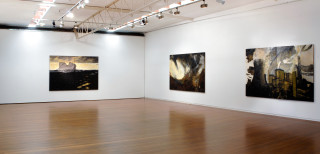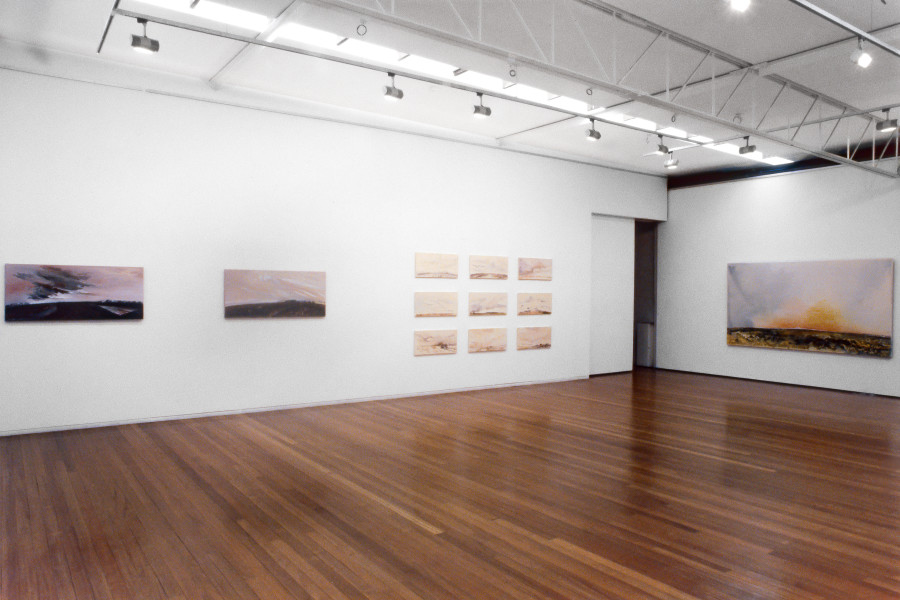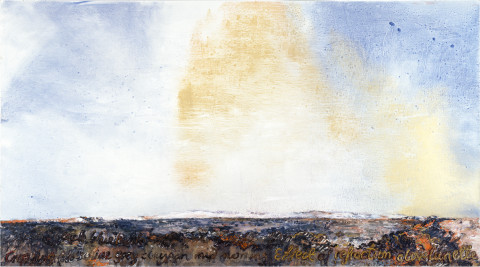Mandy Martin's sixth solo exhibition at Roslyn Oxley9 Gallery.
Exhibition Dates: 7 April – 24 April 1993
Recent Landscapes - 1993
From the beginnings of European settlement the Australian landscape has thrown out challenges to those wanting to express their responses to that landscape in a visual form.
The land has provided the source for some of Australia's most vital and powerful visual statements and continues to provide inspiration in the contemporary world.
Mandy Martin's use of landscape has provided her with the ideal vehicle to encode her own vision of the human condition. Hers is a vision arrived at both through detailed observations of the Australian environment and through detailed "reading" of art historical renderings of the landscape.
The current exhibition is the result of a trip made by the artist at the end of 1992 to Lake Mungo in south-west New South Wales. It is also a synthesis of the amalgamated experiences of several other journeys made by the artist in which she explored and researched Australia's historical landscapes. An integral element of the artist's explorations
is the keeping of a visual diary - annotations at once detailed and general, of sites visited or viewed. This is probably not an unusual practice, but it raises the interesting and relevant analogy of the artist as explorer.
Arguably all art involves a search, an exploration of inner and outer worlds expressed through a multifarious variety of formal languages. Martin's recent art and the actual physical processes attached to it reiterate in her own idiom the topographical art of the eighteenth-and nineteenth-centuries. The eighteenth-century in particular was a period of immense intellectual growth and immense geographical growth (the latter related to voyages of discovery). The combination of these provided artists with rare opportunities to describe the real world as it was being discovered.
The explorer ventures into a world which is by definition unknown and alien. The eighteenth-century explorer was often a scientist, somebody seeking truth and someone
seeking to discover a tangible real world teeming with the details and physical idiosyncrasies which individualize a place, which give a place its own recognizable identity.
The artists who accompanied these explorers became themselves explorers into a new aesthetic. For the most part these artists were schooled in the Picturesque philosophy of landscape painting which required a reorganization and a synthesis of the basic elements found in nature filtered through the encapsulating imagination of the artist. The new world was a disconcerting confrontation. The scientist's interest in natural phenomena involved a deliberate factual study of the external particulars of place.
The artistic precepts of the Picturesque in a sense predicated against this approach by the artist. The combination of the two approaches .resulted in an aesthetic of topography which emulated the habits of observation instilled in the scientist and broke down the barriers between the eighteenth-century ideal of landscape as an imaginary construct and the factual portrait of an actual place.
The aesthetics of topography forces the viewer to make sense of the unknown, to absorb the minutiae of scenery and to inwardly reflect on these to make sensible a continuous and continuing experience. The artist's role is to encapsulate in pictorial form something that is both fugitive and solid - the experience of discovery is a cursory one, the land discovered remains eternal.
Martin's work speaks of this aesthetic. Her wide panoramas are populated with the physical details of place (place is indeed spelt out). Foregrounds act as visual stops before the viewer leaps into the remote landscape and the objects contained therein. We enter the act of exploration through the artist's visual disclosure of her own discovery. For Martin the exploring artist begins a voyage into the world encountered in her travels. It is only by entering that world that the viewer can see demonstrated that art is concerned with an encounter with the self. The self here externalized in a real Australian landscape acts as our guide. These paintings may be records of a particular place, but they express more than that place. The visualisation of the individual gives rise to notions of universality.
Peter Haynes
Canberra
February I 993

mixed media and pencil on recycled rag paper
suite of 9 drawings; 36.5 x 77 cm each
 Mandy Martin Wanderers in the Desert of the Real
Mandy Martin Wanderers in the Desert of the Real
Roslyn Oxley9 Gallery, 2008
 Mandy Martin Salvadoresque
Mandy Martin Salvadoresque
Roslyn Oxley9 Gallery, 2006
 Mandy Martin Absence And Presence
Mandy Martin Absence And Presence
Roslyn Oxley9 Gallery, 2004
 Mandy Martin Salvator Rosa series IV
Mandy Martin Salvator Rosa series IV
Roslyn Oxley9 Gallery, 2002
 Mandy Martin Salvator Rosa Series II
Mandy Martin Salvator Rosa Series II
Roslyn Oxley9 Gallery, 1999
 Mandy Martin Recent Works
Mandy Martin Recent Works
Roslyn Oxley9 Gallery, 1997
 Mandy Martin
Mandy Martin
Roslyn Oxley9 Gallery, 1995
 Mandy Martin
Mandy Martin
Roslyn Oxley9 Gallery, 1993
 Group Show, Christmas show
Group Show, Christmas show
Roslyn Oxley9 Gallery, 1991
 Mandy Martin
Mandy Martin
Roslyn Oxley9 Gallery, 1991
 Mandy Martin
Mandy Martin
Roslyn Oxley9 Gallery, 1989
 Group Show, The Cocktail Party (All Gallery Artists)
Group Show, The Cocktail Party (All Gallery Artists)
Roslyn Oxley9 Gallery, 1988
 Group Show, Chaos
Group Show, Chaos
Roslyn Oxley9 Gallery, 1987
 Mandy Martin
Mandy Martin
Roslyn Oxley9 Gallery, 1986
Mandy Martin
Roslyn Oxley9 Gallery, 1984
Group Show, Australian Visions
Solomon R. Guggenheim Museum, New York, 1984

















